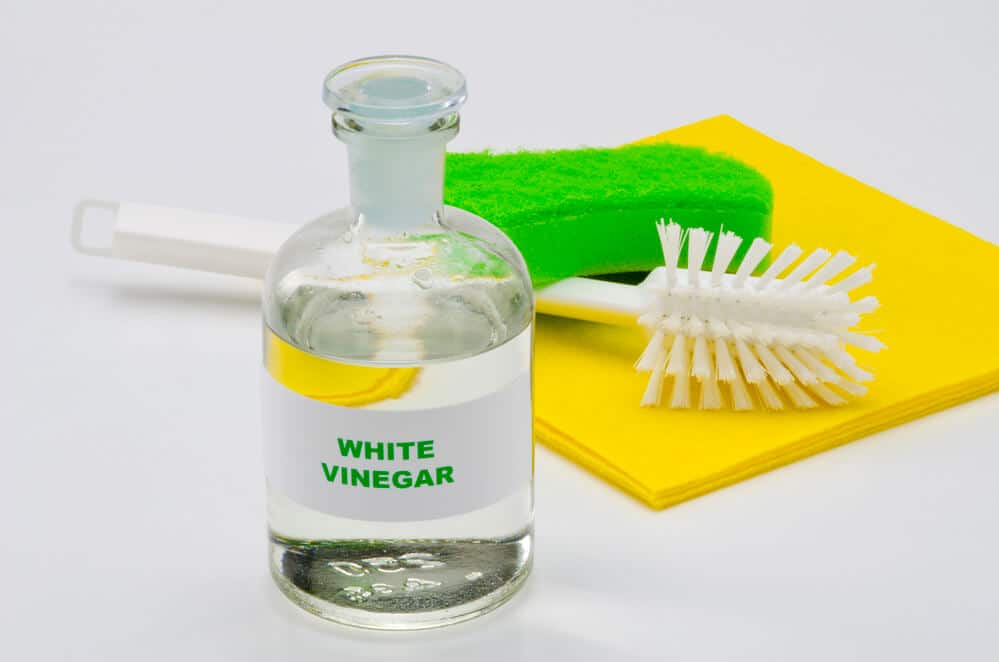Vinegar is a liquid found in our homes and commonly used for cleaning purposes. But it is not suitable for some surfaces, including rubber. Now silicone is also a type of special rubber used in fish tanks.
So, before you use vinegar to clean your tank, it’s a good idea to find out if it’s safe for silicone.
Silicone is a durable material resistant to many chemicals, but it can still be damaged by excessive exposure to certain substances, including vinegar.
For example, suppose the silicone joints in your fish tank are exposed to high concentrations of vinegar for an extended period. In that case, it could cause the silicone to become weakened or even break down completely.
That being said, it’s important to keep in mind that the likelihood of vinegar causing damage to silicone in fish tank joints is relatively low, especially if you are using a small amount of vinegar and only cleaning the tank periodically.
However, it’s always a good idea to use caution and dilute the vinegar with water when cleaning your tank, just to be safe.
Keep reading to learn more about vinegar and its potential risks as a fish tank cleaning agent, the usage procedure, and finally, the best alternative to clean fish tanks.
What You Need To Know About Vinegar Before Using It In Fish Tanks

Vinegar is a liquid that is made from fermented alcohol and is used for cooking and cleaning. It has a strong, sharp taste and is often used to add flavor to food. Vinegar is also used to clean surfaces and kill germs.
Vinegar is also a natural cleaning agent that you can use to kill bacteria and germs, remove stains, and deodorize surfaces. It is often used to clean kitchen and bathroom surfaces, such as countertops, sinks, tiles, and appliances, such as coffee makers and microwaves.
The main active component in vinegar is acetic acid, which gives it its cleaning and disinfecting properties.
Acetic acid is typically a weak acid, but it is strong enough to kill many types of bacteria and germs on contact. It is also effective at breaking down dirt and grime, making it easier to wipe away.
In addition to its cleaning and disinfecting properties, vinegar is also environmentally friendly and biodegradable, making it a popular choice for those looking for a natural alternative to traditional cleaning products.
It’s essential to note that vinegar should not be used on certain surfaces, such as natural stone or marble, as it can damage or etch the surface.
It is also not recommended for wood surfaces, as it can strip away the finish.
Can Vinegar Damage Silicone Seals In Fish Tank Joints?
Silicone is a special type of rubbery material used to hold fish tanks together and keep the water inside. It is strong, flexible, and safe for the fish to be around, making it a great choice for fish tanks.
Fish tanks are typically made up of several pieces of glass that are joined together to form the tank’s walls.
The joints of these glass panels are sealed with silicone (which acts as glue to hold the structure and prevent leaks).
Maintaining the integrity of the silicone layer is essential to keep the fish tank in good condition and prevent any problems, such as water leaks or the glass walls separating from one another.
It’s important to take care when cleaning and to maintain a fish tank to ensure that the silicone joints are not damaged.
Related Read: 7 Reasons Why Fish Tank Cracks (+How To Fix It!)
It is generally believed that vinegar will not cause harm to silicone unless it is left in contact with the material for an extended period.
Many fish keepers have used vinegar as a cleaning agent in their tanks without experiencing problems with the silicone joints or seals. In fact, some fishkeepers have even used straight vinegar and have not reported any issues.
One reason why vinegar may not harm silicone is that it is not a particularly strong acid. When mixed with water, the concentration of acetic acid in vinegar is relatively low, making it unlikely to cause significant damage to silicone or other materials.
Additionally, the rinsing process after cleaning with vinegar helps to remove any residual vinegar from the surface, further reducing the risk of damage.
Overall, it is important to use caution when cleaning with vinegar and to dilute it with water as a precautionary measure.
However, based on the experiences of many fish keepers and the relatively low acidity of the vinegar, it is unlikely that using vinegar as a cleaning agent will cause harm to the silicone joints in your fish tank.
How To Clean Your Fish Tank With Vinegar?
Cleaning your fish tank with vinegar can be an effective and natural way to kill bacteria and germs, remove stains, and deodorize the tank. Here are some steps to follow when cleaning your fish tank with vinegar:
- Remove the fish and any other inhabitants from the tank: It is important to remove the fish and any other creatures, such as snails or plants, from the tank before cleaning. This will prevent them from exposure to the cleaning solution and potentially harmful chemicals.
- Rinse the tank thoroughly: Begin by rinsing the tank thoroughly with clean water to remove any loose dirt or debris.
- Mix a cleaning solution: Mix a cleaning solution by combining equal parts vinegar and water. For a small tank, you may only need a cup or two of each. For larger tanks, you may need to use more.
- Clean the tank: Use a clean cloth or sponge to apply the cleaning solution to the inside of the tank, including the walls, substrate (if applicable), and any decorations or equipment. Be sure to scrub gently to avoid damaging the silicone joints or scratches on the glass.
- Rinse the tank again: Once you have finished cleaning the tank, rinse it thoroughly with clean water to remove any residue.
What Not To Clean With Silicone?
While vinegar is a natural and effective cleaning agent, it is not suitable for all surfaces. Here are some surfaces that you should not clean with vinegar:
- Natural stone: Surfaces made of natural stone, such as marble or granite, can be damaged by vinegar due to its acidic nature.
- Wood: Wood surfaces can be stripped of their finish or discolored if vinegar is exposed.
- Cast iron: Cast iron surfaces can rust if they come into contact with vinegar, which can weaken the material and cause it to deteriorate over time.
- Aluminum: Aluminum surfaces can become discolored or pitted if cleaned with vinegar, weakening the material and making it more prone to damage.
- Copper: Copper surfaces can be damaged by vinegar, as the acid in the vinegar can react with the metal and cause it to become discolored or corroded.
What’s The Best Alternative To Vinegar For Cleaning Fish Tanks?
If you are looking for an alternative to vinegar for cleaning your fish tank, there are several options to consider:
#1. Baking soda:
Baking soda is also a natural and effective cleaning agent that you can use to remove stains and deodorize surfaces.
It is safe for fish tanks and can be mixed with water to create a cleaning solution. It is a mild abrasive that you can use to remove dirt and stains without damaging the surface.
In general, baking soda is not likely to cause damage to silicone, as it is a relatively weak alkaline substance. Baking soda is also usually considered a safe substance on rubber or glass products. So you can use it without any issues.
#2. Aquarium-safe cleaning agents:
Many commercial cleaning products are also available specifically designed for fish tanks and are safe for use around aquatic life. These products can effectively remove dirt, algae, and other contaminants and are often easier to use than homemade cleaning solutions.
For instance, you can check out the API Safe And Easy Aquarium Cleaner.
This cleaning solution is specifically designed to effectively clean glass or acrylic aquariums’ interior and exterior surfaces. And the good thing is it is also safe for plants and fish inside the aquarium.
Final Takeaways
So, can vinegar damage silicone in fish tank joints? It’s possible, but the likelihood is very low. And with proper caution and care, it can still be useful in maintaining a clean and healthy tank environment for your fish. Just be sure to use it in moderation and always dilute it with water before use. Happy cleaning!
Also See: Can You Use Bottled Water In An Aquarium?
Hi! I’m Praveen Ghoshal, the founder of eFishkeeping.com. Inspired by my Dad, I got interested in fishkeeping when I was a kid. Since then, I have been involved with this hobby. Currently, I have 3 fish tanks at our home, and I enjoy this hobby with my full family. Read more about me here.







